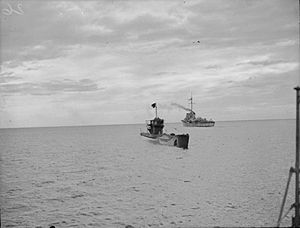German submarine U-1009 facts for kids

U-1009 surrendering at Loch Eriboll Scotland, behind is the frigate HMS Byron in May 1945
|
|
Quick facts for kids History |
|
|---|---|
| Name | U-1009 |
| Ordered | 23 March 1942 |
| Builder | Blohm & Voss, Hamburg |
| Yard number | 209 |
| Laid down | 24 February 1943 |
| Launched | 5 January 1944 |
| Commissioned | 10 February 1944 |
| Fate |
|
| General characteristics | |
| Type | Type VIIC/41 submarine |
| Displacement |
|
| Length |
|
| Beam |
|
| Height | 9.60 m (31 ft 6 in) |
| Draught | 4.74 m (15 ft 7 in) |
| Installed power |
|
| Propulsion |
|
| Speed |
|
| Range | |
| Test depth |
|
| Complement | 44-52 officers & ratings |
| Armament |
|
| Service record | |
| Part of: |
|
| Commanders: |
|
| Operations: |
|
| Victories: | None |
German submarine U-1009 was a Type VIIC/41 U-boat of Nazi Germany's Kriegsmarine during World War II.
She was ordered on 23 March 1942, and was laid down on 24 February 1943, at Blohm & Voss, Hamburg, as yard number 209. She was launched on 5 January 1944, and commissioned under the command of Oberleutnant zur See Klaus Hilgendorf on 10 February 1944.
Design
German Type VIIC/41 submarines were preceded by the heavier Type VIIC submarines. U-1009 had a displacement of 769 tonnes (757 long tons) when at the surface and 871 tonnes (857 long tons) while submerged. She had a total length of 67.10 m (220 ft 2 in), a pressure hull length of 50.50 m (165 ft 8 in), an overall beam of 6.20 m (20 ft 4 in), a height of 9.60 m (31 ft 6 in), and a draught of 4.74 m (15 ft 7 in). The submarine was powered by two Germaniawerft F46 four-stroke, six-cylinder supercharged diesel engines producing a total of 2,800 to 3,200 metric horsepower (2,060 to 2,350 kW; 2,760 to 3,160 shp) for use while surfaced, two BBC GG UB 720/8 double-acting electric motors producing a total of 750 metric horsepower (550 kW; 740 shp) for use while submerged. She had two shafts and two 1.23 m (4 ft) propellers. The boat was capable of operating at depths of up to 230 metres (750 ft).
The submarine had a maximum surface speed of 17.7 knots (32.8 km/h; 20.4 mph) and a maximum submerged speed of 7.6 knots (14.1 km/h; 8.7 mph). When submerged, the boat could operate for 80 nautical miles (150 km; 92 mi) at 4 knots (7.4 km/h; 4.6 mph); when surfaced, she could travel 8,500 nautical miles (15,700 km; 9,800 mi) at 10 knots (19 km/h; 12 mph). U-1009 was fitted with five 53.3 cm (21 in) torpedo tubes (four fitted at the bow and one at the stern), fourteen torpedoes or 26 TMA or TMB Naval mines, one 8.8 cm (3.46 in) SK C/35 naval gun, (220 rounds), one 3.7 cm (1.5 in) Flak M42 and two 2 cm (0.79 in) C/30 anti-aircraft guns. The boat had a complement of between forty-four and fifty-two.
Service history
U-1009 participated in two war patrols which resulted in no ships damaged or sunk.
U-1009 had a Schnorchel underwater-breathing apparatus fitted out sometime before November 1944.
On 10 May 1945, U-1009 surrendered at Loch Eriboll, Scotland and was transferred to Lisahally then Loch Ryan. Of the 156 U-boats that eventually surrendered to the Allied forces at the end of the war, U-1009 was one of 116 selected to take part in Operation Deadlight. U-1009 was towed out and sank on 16 December 1945, by naval gunfire.
The wreck now lies at 55°31′N 07°24′W / 55.517°N 7.400°W.
See also

